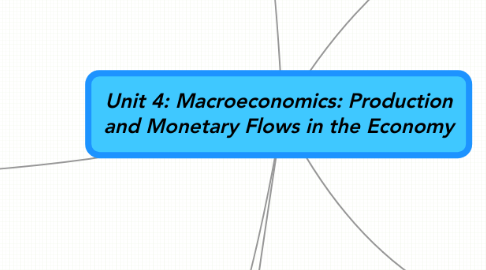
1. BUSINESS CYCLE
1.1. Economic Growth and Recession
1.2. Recovery: First part of the expansionary period
1.3. Peak: High inflationary pressure
1.4. Recession: Real GDP growth is negative
1.5. Depression: Prolonged recession
1.6. Trough: Economic activity does not decrease
1.7. Economist: John Maynard Keynes
2. MACROECONOMICS
2.1. Key Measures of Performance
2.1.1. Output
2.1.2. Employment Levels
2.1.3. Price Stability
2.2. GDP
2.2.1. Income Approach
2.2.1.1. Income of Household
2.2.1.2. Income of Businesses
2.2.1.3. Income of Government
2.2.2. Expenditure Approach
2.2.2.1. GDP= C + I + G + (X-M)
2.2.3. INCOME GDP = EXPENDITURE GDP
2.2.4. Does not account for
2.2.4.1. Inflation
2.2.4.2. Household Production
2.2.4.3. Illegal Production
2.2.4.4. Leisure Time
2.2.4.5. Quality of Life
2.2.5. GNP
2.3. Unemployment
2.3.1. Rate
2.3.1.1. Unemployment Rate = (# unemployed)/(labour force) x 100
2.3.1.2. Employment Rate = (# employed)/(labour force) x 100
2.3.2. Limitations
2.3.2.1. Underemployment
2.3.2.2. Discouraged workers
2.3.2.3. Dishonesty
2.3.3. Types
2.3.3.1. Frictional
2.3.3.2. Seasonal
2.3.3.3. Structural
2.3.3.4. Cyclical
2.3.4. Measurement
2.3.4.1. Full Employment
2.3.4.2. Okun's Law
2.3.4.3. GDP gap = current GDP x ((current UE rate-FE rate) x 2)/100
2.4. Inflation
2.4.1. Measurement
2.4.1.1. Consumer Price Index
2.4.1.1.1. Limitations
2.4.1.2. CPI = (Current Year Cost of Basket)/(Base Year Cost of Basket) x 100
2.4.2. Types
2.4.2.1. Demand-Pull Inflation
2.4.2.2. Cost-Push Inflation
3. FISCAL POLICY
3.1. Expansionary Fiscal Policy
3.1.1. Cut taxes
3.1.2. Increase government spending
3.2. Contractionary Fiscal Policy
3.2.1. Increase taxes
3.2.2. Decrease government spending
3.3. Automatic Stabilizers
3.4. Drawback
3.4.1. Time lags
3.4.2. Recession period > Recovery period
3.5. Cyclical Balanced Budgets
3.5.1. Business cycle to make fiscal decisions
3.5.2. Government intervention
4. GRAPHS
4.1. Philips Curve
4.2. Business Cycle
4.3. Aggregate Demand
4.4. Aggregate Supply
5. MONEY
5.1. History
5.1.1. Commodities
5.1.2. Coinage
5.1.3. Paper receipts
5.1.4. Paper currency
5.2. Function: exchange, measure and value
5.3. Characteristics: Portable, durable, divisible, distinguishable, limited, hard to counterfeit
5.4. Currency
5.4.1. Exchange Rates
5.4.2. Conversions
5.5. Baking Systems
5.5.1. Branch banking
5.5.2. Unit banking
5.5.3. Chartered banks
5.5.4. Central Banks
5.5.4.1. Bank of Cnaada
5.6. Interest Rates
5.6.1. Prime Rate
5.6.2. Bank Rate
5.6.2.1. Bank of Canada Rate
5.6.2.2. Overnight Rate
6. MONETARY POLICIES
6.1. Interest Rates
6.1.1. Affects on Demand
6.1.2. Affects on Supply
6.2. Government
6.2.1. Makes sure Canada has money for goods and services
6.3. Easy Money Policy
6.3.1. Problem: Recession
6.3.2. Stage 1: BoC increases reserves - interest rates decrease
6.3.3. Stage 2: consumer and business spending increases
6.3.4. Stage 3: money supply growth increases
6.3.5. Stage 4: GDP increases
6.4. Tight Money Policy
6.4.1. Problem: High Inflation
6.4.2. Stage 1: BoC decreases reserves - interest rates increase
6.4.3. Stage 2: consumer and business spending decreases
6.4.4. Stage 3: money supply growth decreases
6.4.5. Stage 4: GDP decreases
